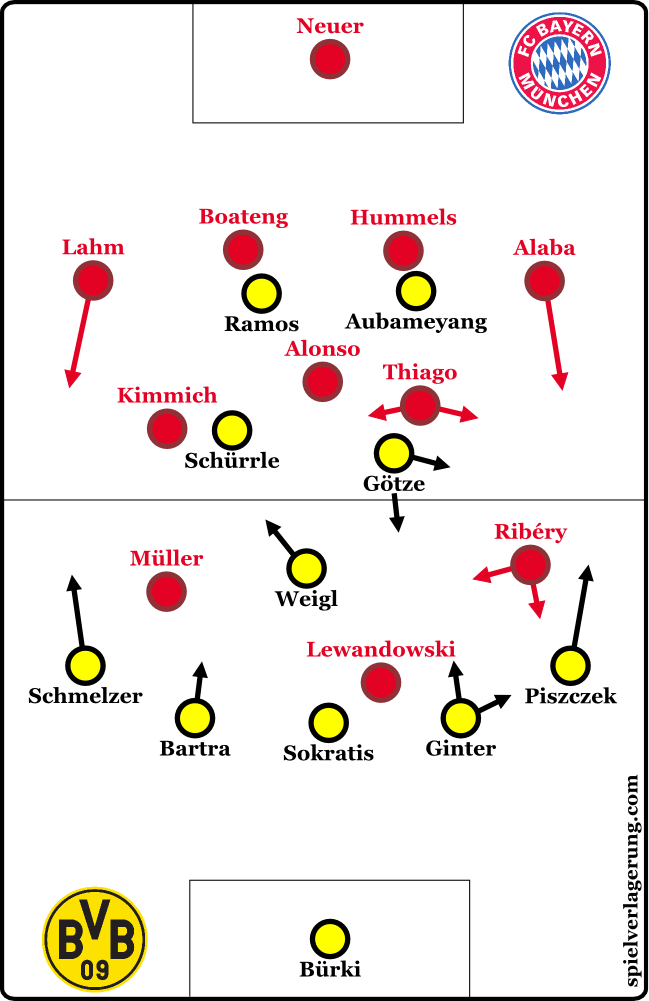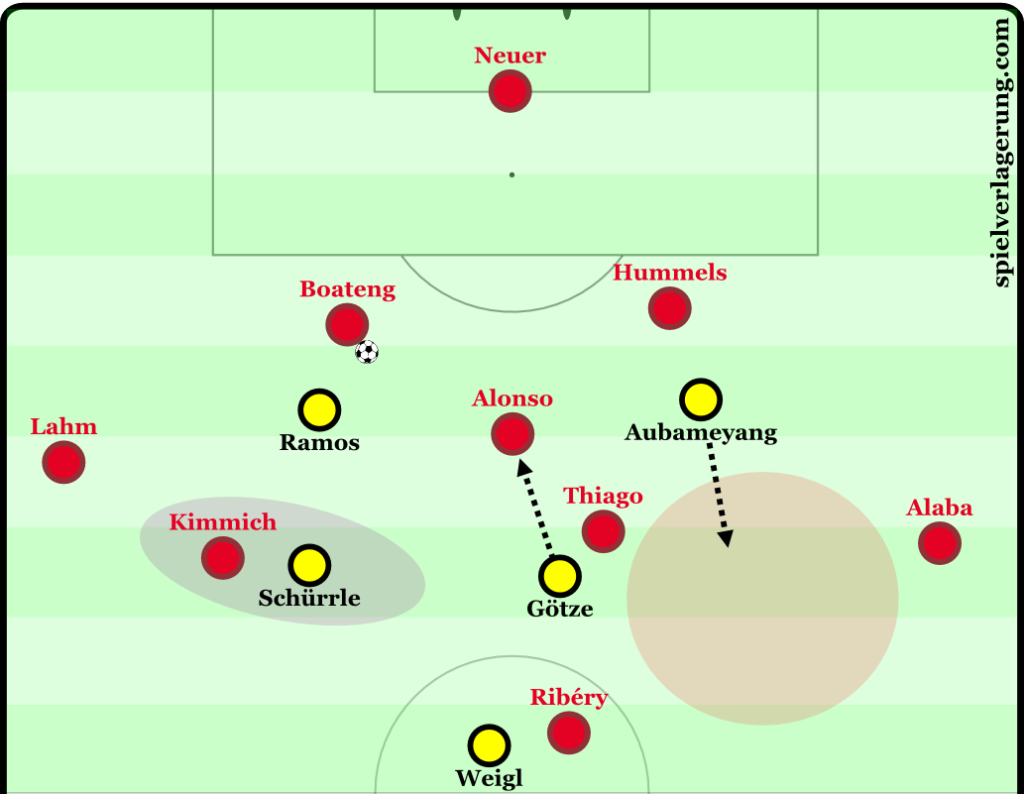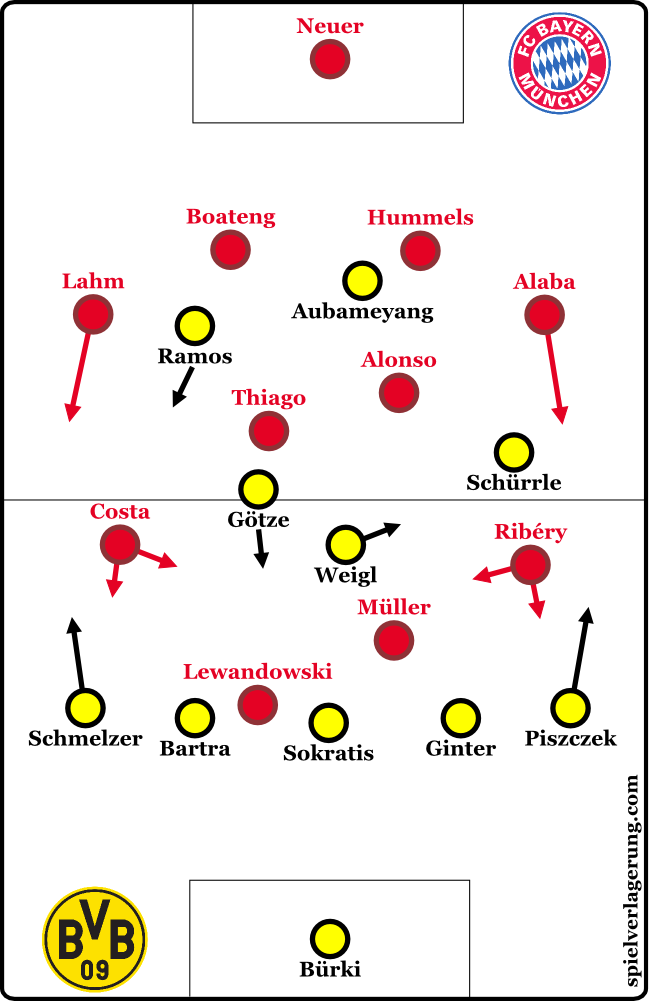Tuchel’s play with fire pays off
In what is considered the Bundesliga blockbuster Borussia Dortmund were able to secure a 1-0 win over Bayern Munich. Thomas Tuchel’s side scored an early goal and protected the lead to the end, despite Bayern’s continuous control after 25 minutes.
Tuchel decided to employ a rather unusual 5-3-2, with Adrian Ramos and Pierre-Emerick Aubameyang up front. Even more surprising were the roles of Mario Götze and André Schürrle. Both served as central midfielders, controlling the space in front of deep-lying playmaker Julian Weigl.
Meanwhile, Carlo Ancelotti stuck to his customary 4-3-3. In absence of Chilean powerhouse Arturo Vidal, the Italian head coach fielded Thiago Alcántara and Joshua Kimmich in central midfield. Xabi Alonso once again roamed in front of the centre-backs. Thomas Müller replaced injured Arjen Robben on the right flank, while Franck Ribéry was Bayern’s left-winger—at least on paper.
Dortmund in full force
The first phase of the match saw Dortmund in intense pressing mode. Using their 5-3-2 formation to its fullest potential, Ramos and Aubameyang kept attacking Bayern’s centre-backs, while Götze and Schürrle put pressure on the opposing playmakers. Götze in particular filled an intriguing yet uncommon role. The 24-year-old received the order to move to the middle during Dortmund’s first phase of pressing. There he switched between marking Xabi Alonso and Thiago.
Logically, Götze abandoned covering the right side where you would have expected Ribéry benefiting from a lack of Götze’s presence. But as the Frenchman often drifted to the centre himself, he did not take advantage of the situation. Meanwhile, Götze enjoyed support by Dortmund’s right-sided centre-forward—usually Gabonese phenomenon Aubameyang—who repeatedly dropped back to fill in the half-space. This also enabled Aubameyang to wait for passes after quick turnovers without being within the reach of defender Mats Hummels.
Götze’s intense style of defending neutralised Bayern’s control centre for quite some time. The young attacking midfielder really showcased his defensive skills in this match. And he, as well as his partner in crime Schürrle, behaved very disciplined in the second and third phases of Dortmund’s pressing, as both always smoothly dropped back eventually ending up next to Weigl while covering the important horizontal band in front of the back five.
Speaking of which, both Marc Bartra and Matthias Ginter were pretty active, leaving their initial position repeatedly in order to pressure Ribéry or Müller. Ginter, for instance, was confident to push forward attacking Ribéry, but also remained aware of the threat posed by Robert Lewandowski who tended to drift a bit to the left in the first half.
Change in momentum
It was clear from the beginning that Dortmund could not keep up that degree of intensity until the final whistle. Luckily for them, Aubameyang scored the go-ahead goal in the 11th minute. Moments before Aubameyang tipped the ball in, Bayern were not able to clear the situation at the edge of their penalty area. At the end, Götze received the ball on the right, showed great body posture and peripheral awareness, as he waited for Hummel’s legs to offer a gap where Götze put the ball through.
After about 25 minutes, Dortmund took the foot off the gas pedal. Facing a much more controlled Dortmund pressing, Bayern begun to let the ball circulating through their half and therefore slowed the match down. The lack of dynamism and chaos around the halfway line favoured Bayern’s controlled way of building up attacks. Ancelotti’s side methodically pushed Dortmund back yard after yard, which led to BVB’s pressing eventually collapsing.
Götze and Schürrle now leaned against the back five instead of pressuring the likes of Alonso and Thiago. Dortmund’s centre-backs became reluctant to leave their positions, which was one of many reasons that the hosts’ defensive formation turned into a static structure. Standing flat-footed made it far more difficult to shut down Bayern’s talented wingers.
Battle of attrition after the break
The direction of the game remained the same following the interval, with Bayern moving forward while Dortmund were trying to keep their rivals off the goal. That said, throughout the second half Aubameyang had two opportunities to close the show, both came via counterattacks.
Tuchel made slight adjustments during the break. Schürrle switched to the right side. Götze played as left-sided central midfielder, while Ramos frequently dropped to the left side after Dortmund’s initial pressing attempts. That variation of a 5-4-1 was supposed to the shut down the passing lanes towards Lewandowski who remained isolated until, 13 minutes into the second half, Ancelotti decided to change the system of his team intending to turn things around.
He brought on Douglas Costa who replaced Kimmich. Consequently, Bayern now played in a 4-4-2, with Müller being finally allowed to move to the middle. Costa posed a unique threat to Dortmund’s defence, as the Brazilian right-winger hugged the touchline exploring the outside lane next to left-back Marcel Schmelzer. As Schmelzer chose to stay close to Lewandowski who started roaming through the right half-space, the 28-year-old skipper left the wing open to the delight of Costa. Ten minutes after Costa’s substitution, Tuchel decided to react to the new situation, when he brought on Erik Durm as an additional player for the left side, while Götze moved back to the right.
By that time, it became apparent that Ancelotti had shown his cards. He brought on fresh legs in Rafinha and Renato Sanches, but did not make another tactical adjustment. His only move was to have Costa patrol on the right side. After that, he was hoping that his players could figure out how to use the open wing zones and half-spaces, as an exhausted Dortmund side were not quick enough anymore to close the zones, especially when Bayern rapidly switched sides or penetrated the hole behind Lewandowski with aggressive passing.
Conclusion
Bayern did not score the equalising goal. Tuchel was aware that his team could not defend as intensively as they did in the first 25 minutes. But besides a few occasions in which Lewandowski and his team-mates managed to break through and caused havoc in Dortmund’s box, the hosts seemed to be comfortable dropping back in a compact 5-3-2 or 5-4-1.
Tuchel’s strategy paid off and earned the Black and Yellows a victory over the rivals from the South. Of course, if Bayern had pulled off a draw or win at the end, the post-match discussion would have looked quite different. So it is Ancelotti who has to answer questions about his team’s stagnation and his one-dimensional tactical approach, highlighted by the structural weaknesses of Bayern’s current 4-3-3.






5 Kommentare Alle anzeigen
steve November 26, 2016 um 12:17 pm
Then, you think that the losing point of bayern is Ancelotti’s tactics? Even though Dortmund’s defensive-aim tactics (like horizontal defence line) are good, But I don’t think that Tuchel’s defensive-aim tactics are the reason of borussen’s win over bayern.
CE November 27, 2016 um 1:03 pm
What do you think was the reason for the result in this match?
Steve November 29, 2016 um 4:35 am
Bayern’s misfortune? Missing so many goal chances
CE November 29, 2016 um 8:46 am
The ExpG sum was 1.4 to 1.0 in favour of Dortmund. https://twitter.com/Caley_graphics/status/800063935567294466
mlisiewi December 2, 2016 um 10:09 am
Misfortune? Except Alsonos chance, what kind of great opportunities were on Munich’s side???